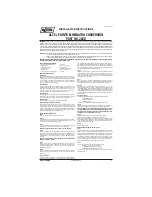
4-7
DRIVING YOUR VEHICLE
85Z04-03E
gerous move, since the passing vehicle
occupies the same lane as oncoming traf-
fic for several seconds. A miscalculation,
an error in judgment, or a brief surrender to
frustration or anger can suddenly put the
passing driver face to face with the worst of
all traffic accidents – the head-on collision.
So here are some tips for passing:
• “Drive ahead.” Look down the road, to
the sides and to crossroads for situa-
tions that might affect your passing pat-
terns. If you have any doubt whatsoever
about making a successful pass, wait for
a better time.
• Watch for traffic signs, pavement mark-
ings and lines. If you can see a sign up
ahead that might indicate a turn or an
intersection, delay your pass. A broken
center line usually indicates it’s all right
to pass (providing the road ahead is
clear). Never cross a solid line on your
side of the lane or a double solid line,
even if the road seems empty of
approaching traffic.
• Do not get too close to the vehicle you
want to pass while you’re awaiting an
opportunity. For one thing, following too
closely reduces your area of vision,
especially if you’re following a larger
vehicle. Also, you won’t have adequate
space if the vehicle ahead suddenly
slows or stops. Keep back a reasonable
distance.
• When it looks like a chance to pass is
coming up, start to accelerate but stay in
the right lane and don’t get too close.
Time your move so you will be increas-
ing speed as the time comes to move
into the other lane. If the way is clear to
pass, you will have a “running start” that
more than makes up for the distance you
would lose by dropping back. And if
something happens to cause you to can-
cel your pass, you need only slow down
and drop back again and wait for another
opportunity.
• If other vehicles are lined up to pass a
slow vehicle, wait your turn. But take
care that someone isn’t trying to pass
you as you pull out to pass the slow vehi-
cle. Remember to glance over your
shoulder and check the blind spot.
• Check your mirrors, glance over your
shoulder, and start your left lane change
signal before moving out of the right lane
to pass. When you are far enough ahead
of the passed vehicle to see its front in
your inside mirror, activate your right
lane change signal and move back into
the right lane. (Remember that your right
outside mirror is convex. The vehicle you
just passed may seem to be farther away
from you than it really is.)
• Try not to pass more than one vehicle at
a time on two-lane roads. Reconsider
before passing the next vehicle.
• Don’t overtake a slowly moving vehicle
too rapidly. Even though the brake lamps
are not flashing, it may be slowing down
or starting to turn.
• If you’re being passed, make it easy for
the following driver to get ahead of you.
Perhaps you can ease a little to the right.
Loss of Control
Let’s review what driving experts say about
what happens when the three control sys-
tems (brakes, steering and acceleration)
don’t have enough friction where the tires
meet the road to do what the driver has
asked.
In any emergency, don’t give up. Keep try-
ing to steer and constantly seek an escape
route or area of less danger.
Skidding
In a skid, a driver can lose control of the
vehicle. Defensive drivers avoid most skids
by taking reasonable care suited to exist-
ing conditions, and by not “overdriving”
those conditions. But skids are always pos-
sible.
The three types of skids correspond to
your vehicle’s three control systems. In the
braking skid, your wheels aren’t rolling. In
the steering or cornering skid, too much
speed or steering in a curve causes tires to
slip and lose cornering force. And in the
acceleration skid, too much throttle causes
the driving wheels to spin.
A cornering skid is best handled by easing
your foot off the accelerator pedal.
If your vehicle starts to slide, ease your
foot off the accelerator pedal and quickly
Your Driving, the Road, and Your Vehicle:
Содержание Automible 2008 Forenza
Страница 2: ...Prepared by July 2007 Part No 99011 85Z04 03E Printed in U S A TP222...
Страница 11: ...0 4...
Страница 75: ...2 27 FEATURES AND CONTROLS MEMO...
Страница 124: ...DRIVING YOUR VEHICLE 4 DRIVING YOUR VEHICLE Your Driving the Road and Your Vehicle 4 1 Towing 4 16...
Страница 200: ...MAINTENANCE SCHEDULE 6 MAINTENANCE SCHEDULE General Information 6 1 Maintenance 6 2...
Страница 211: ...6 11 MAINTENANCE SCHEDULE Maintenance Record Date Odometer Reading Serviced By Maintenance Record...
Страница 212: ...6 12 MAINTENANCE SCHEDULE Maintenance Record Date Odometer Reading Serviced By Maintenance Record...
Страница 213: ...6 13 MAINTENANCE SCHEDULE Maintenance Record Date Odometer Reading Serviced By Maintenance Record...
Страница 219: ...7 5 GENERAL INFORMATION MEMO...
Страница 225: ...8 6 INDEX Y Your Driving the Road and Your Vehicle 4 1...
















































